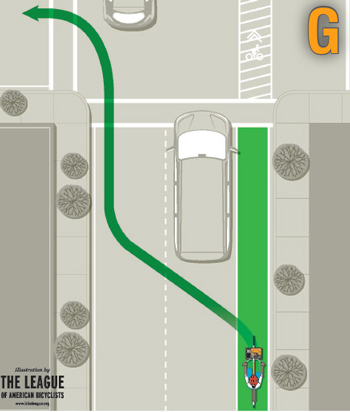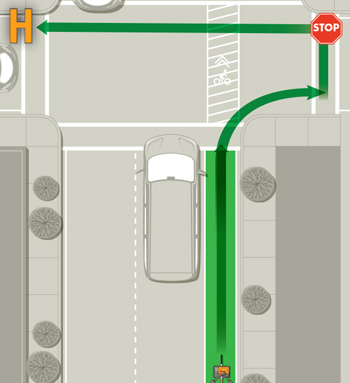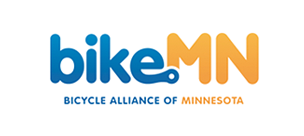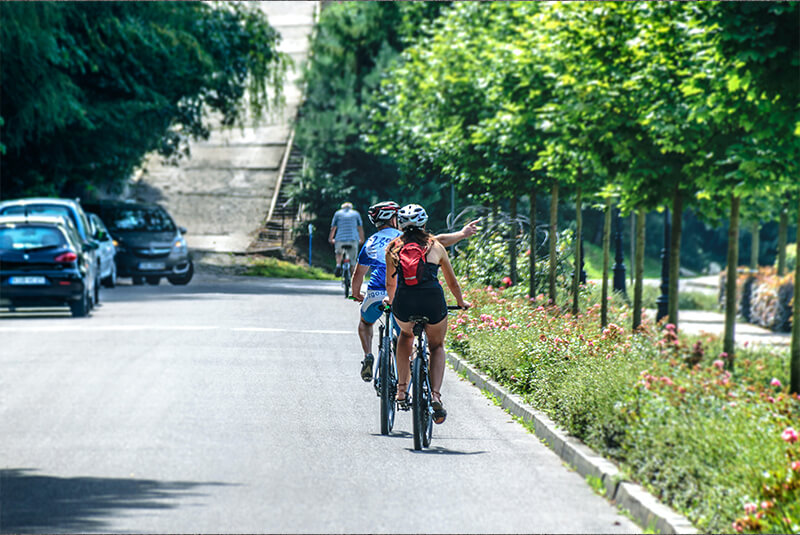Bicycles are vehicles in Minnesota and all the other states. Bicyclists have the same rights and responsibilities as the drivers of other vehicles. Motorists who don’t follow the rules of the road endanger bicyclists. They often “don’t see” cyclists, or understand the road hazards and conditions that bicyclists face. Motorists also often misjudge the speed of bicyclists. Help protect yourself by riding smart, following all traffic laws, and riding predictably, consistently, and attentively.
First Come, First Served
Just like other vehicles, bikes have a right to space on the road. Other vehicles must yield space to bikes that occupy a space first just as bicycles must yield space to motor vehicles that occupy space first. This rule applies both between intersections and at intersections. Like motor vehicles, bicyclists must also yield when changing lanes.
Yield to Crossing Traffic
Drivers on less important roads, including driveways and alleys, must yield to traffic on the roadway to be entered or crossed. Yielding means looking until you see that no traffic is so close as to be a danger. Before changing lanes, bikes must check to see that a space is clear. If it is not clear, a bicycle must yield to a car in that space before making the change.
Direction of Travel
Always ride in the direction of traffic. Never ride against traffic (on the left side of the road). You may, however, ride with traffic in the far left lane on one-way streets when preparing to make a left turn.
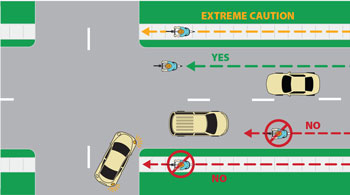
Sidewalk Riding
Sidewalk riding is more than twice as dangerous (and in some cases illegal) as riding on the road. Drivers often don’t notice you. If you do ride on sidewalks, be extra alert when crossing driveways and intersections, and always yield to pedestrians. (More about sidewalk riding here.)
Speed Positioning and Passing
The slowest vehicle should be in the right-most position and the fastest on the left. That puts parked drivers at the curb, slower drivers next to them, and fast drivers next to them. Passing should take place on the left. There are a few exceptions, such as a vehicle ahead turning left, when passing happens on the right. This is why caution should ALWAYS be used when passing slow or stopped traffic on the right, such as in a bike lane or on a shoulder. Motorists are not expecting to be passed on the right. Also, passing on the right means passing in blind spot. Always watch a vehicle’s front right wheel to see if it may make a sudden move to the right.
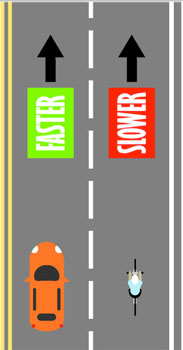
Lane Positioning to Avoid Hazards & “Squeezing”
Stay to the right, but don’t hug the curb. By riding away from the curb in the right wheel track of vehicles, usually a minimum of 24 inches away from the road edge, you discourage drivers from “squeezing” you by passing too closely in the same travel lane.
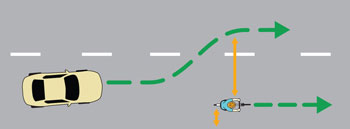
When to Share the Lane
Bikes can share the same lane with other drivers under certain conditions. If a lane is wide enough to share with another vehicle (at least 14 feet), ride at least two feet from the road edge to avoid debris and hazards.
Frequently, travel lanes are not wide enough to share (usually less than 14 feet). If you deem a vehicle can not safely pass you (with a minimum of 3 feet) in the lane, you can “take the lane” to signal to traffic that they must pass you in the other lane. This protects you from drivers passing too closely. Position yourself as if you were a car by riding in the right wheel track of motorized traffic or the center of the lane in a narrow lane. This places you within motorists’ fields of vision sooner and allows them more time to prepare to pass. This positioning also allows you space to move away from traffic to avoid debris, hazards such as car doors opening when parallel parking is present, and “crowding” by other vehicles. Riding here also properly prepares you to make left turns or to pass other road users.
Intersection Positioning
At intersections, follow the rules of the road as any other driver would. At intersections, there is a certain position drivers need to place themselves:
- One Lane: When approaching an intersection with one lane, position yourself in the lane with respect to your destination direction. (Diagram A)
- Multi-Lane: When coming up to an intersection with multiple lanes, place yourself in the rightmost lane that is traveling in the direction you’re going. (Diagram B)
- Multiple Left Turn Lanes: When turning left on a road with multiple left turn lanes, select the rightmost lane that serves your destination. (Diagram C)
- One-Way Streets with Two or More Lanes: When you make a left turn from a one-way street onto another one-way street, it’s easiest to turn from the left-most lane. (Diagram D)
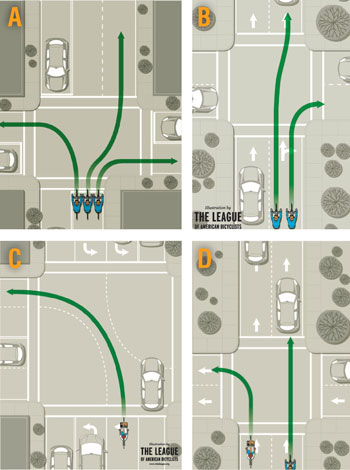
Two Abreast Rules & Etiquette
Riding two abreast is legal in Minnesota. Bicyclists, however, can receive citations for riding more than two abreast. Bicyclists often ride next to one another when dangerous road conditions exist that make it unsafe for drivers to pass in the same travel lane. BikeMN encourages bicyclists to be courteous and “single up” when other road users are present and it is safe to do so. You may never ride more than two abreast.
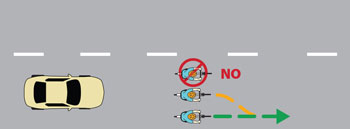
Crossing Railroad Tracks
Many railroad tracks cross roads diagonally. To prevent catching a tire in the track, slow down and cross at a right angle. It’s especially important to do this in wet weather conditions.

Stopping
When stopping for a rest or emergency, move completely off the road into the shoulder.
Where to Ride: Bike Lanes, Travel Lanes
While you are not required to use them, bike lanes and paved shoulders are often the safest place to ride, especially where motor vehicle speeds exceed 45 MPH or heavy traffic is present. When facilities are not available, maintained, or the traffic conditions warrant, bicyclists must use standard travel lanes. The safest way to do so is by identifying conditions and assessing the usable space.
Bike Lane Considerations
Bike lanes are not always designed to give cyclists enough room to stay in the bike lanes and outside of the “door zone” (where driver’s side doors of parked cars open). Remember, the door zone is at least 3 feet so give parked cars at least 4 feet. (Diagram E)
Be sure to scan and signal to other traffic when moving out of the bike lane and into the travel lane. When in a bike facility that ends at an intersection, use caution and position yourself to avoid conflict with right turning motorists. (Diagram F)
NOTE: It is NOT legal in Minnesota to continue straight in the right-turn-only lane as shown in Diagram F. Technically, in the shown situation, the bicyclist should scan, yield, and move left into the travel lane. However, there may be times when it is dangerous to move into the adjacent lane, such as high speed rural roads where shoulders end or there is lots of faster moving traffic on the left. Use good judgment and extreme caution in these situations.
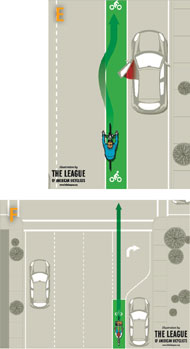
Turning from a Bikeway
When making a left turn from a right side bikeway, scan, signal, and exit the bikeway early. Turn left from the proper road lane (Diagram G). An alternative is to make a box turn by stopping in the intersection, turning your bike with traffic, and proceeding when the traffic signal changes. (Diagram H)
